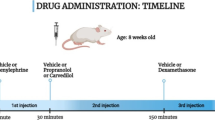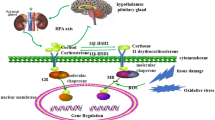Abstract
Dexamethasone is a potent and widely used anti-inflammatory and immunosuppressive drug. However, recent evidences suggest that dexamethasone cause pathologic cardiac remodeling, which later impairs cardiac function. The mechanism behind the cardiotoxic effect of dexamethasone is elusive. The present study aimed to verify if dexamethasone-induced cardiotoxicity would be associated with changes in the cardiac net balance of calcium handling protein and calcineurin signaling pathway activation. Wistar rats (~400 g) were treated with dexamethasone (35 µg/g) in drinking water for 15 days. After dexamethasone treatment, we analyzed cardiac function, cardiomyocyte diameter, cardiac fibrosis, and the expression of proteins involved in calcium handling and calcineurin signaling pathway. Dexamethasone-treated rats showed several cardiovascular abnormalities, including elevated blood pressure, diastolic dysfunction, cardiac fibrosis, and cardiomyocyte apoptosis. Regarding the expression of proteins involved in calcium handling, dexamethasone increased phosphorylation of phospholamban at threonine 17, reduced protein levels of Na+/Ca2+ exchanger, and had no effect on protein expression of Serca2a. Protein levels of NFAT and GATA-4 were increased in both cytoplasmic and nuclear faction. In addition, dexamethasone increased nuclear protein levels of calcineurin. Altogether our findings suggest that dexamethasone causes pathologic cardiac remodeling and diastolic dysfunction, which is associated with impaired calcium handling and calcineurin signaling pathway activation.










Similar content being viewed by others
References
Cherrington AD (1999) Banting lecture 1997. Control of glucose uptake and release by the liver in vivo. Diabetes 48(5):1198–1214
Naves A (2010) Nutrição Clínica Funcional: Modulação Hormonal, 1st edn. VP Editora, São Paulo
Severino C, Brizzi P, Secchi G, Maioli M, Tonolo G (2002) Low-dose dexamethasone in the rat: a model to study insulin resistance. Am J Physiol Endocrinol Metab 283(2):E367–E373
Barnes PJ, Adcock I (1993) Anti-inflammatory actions of steroids: molecular mechanisms. Trends Pharmacol Sci 14(12):436–441
Romanholi DJ, Salgado LR (2007) Exogenous Cushing’s syndrome and glucocorticoid withdrawal. Arq bras endocrinol metab 51(8):1280–1292
Qi D, Rodrigues B (2007) Glucocorticoids produce whole body insulin resistance with changes in cardiac metabolism. Am J Physiol Endocrinol Metab 292(3):E654–E667
Van Staa TP, Leufkens HG, Abenhaim L, Begaud B, Zhang B, Cooper C (2000) Use of oral corticosteroids in the United Kingdom. QJM: Mon J Assoc Physicians 93(2):105–111
Bernal-Mizrachi C, Weng S, Feng C, Finck BN, Knutsen RH, Leone TC et al (2003) Dexamethasone induction of hypertension and diabetes is PPAR-alpha dependent in LDL receptor-null mice. Nat Med 9(8):1069–1075
Iannoli P, Miller JH, Ryan CK, Sax HC (1998) Glucocorticoids upregulate intestinal nutrient transport in a time-dependent and substrate-specific fashion. J Gastrointest Surg 2(5):449–457
Stahn C, Buttgereit F (2008) Genomic and nongenomic effects of glucocorticoids. Nat Clin Pract Rheumatol 4(10):525–533
Walker BR (2007) Glucocorticoids and cardiovascular disease. Eur J Endocrinol 157(5):545–559
Bal MP, de Vries WB, Steendijk P, Homoet-van der Kraak P, van der Leij FR, Baan J et al (2009) Histopathological changes of the heart after neonatal dexamethasone treatment: studies in 4-, 8-, and 50-week-old rats. Pediatr Res 66(1):74–79
Saad MJ, Folli F, Araki E, Hashimoto N, Csermely P, Kahn CR (1994) Regulation of insulin receptor, insulin receptor substrate-1 and phosphatidylinositol 3-kinase in 3T3-F442A adipocytes. Effects of differentiation, insulin, and dexamethasone. Mol Endocrinol 8(5):545–557
Taliari KRS (2004) The dexamethasone action in creatine supplement muscle. Saude book. 10:4
Maxwell SR, Moots RJ, Kendall MJ (1994) Corticosteroids: do they damage the cardiovascular system? Postgrad Med J 70(830):863–870
Sicard RE, Werner JC (1995) Biochemical correlates of dexamethasone-induced relative cardiomegaly in neonatal rats. In vivo 9(1):75–79
Rao MK, Xu A, Narayanan N (2001) Glucocorticoid modulation of protein phosphorylation and sarcoplasmic reticulum function in rat myocardium. Am J Physiol Heart Circ Physiol 281(1):H325–H333
Yagyu H, Chen G, Yokoyama M, Hirata K, Augustus A, Kako Y et al (2003) Lipoprotein lipase (LpL) on the surface of cardiomyocytes increases lipid uptake and produces a cardiomyopathy. J Clin Investig 111(3):419–426
Newell-Price J, Bertagna X, Grossman AB, Nieman LK (2006) Cushing’s syndrome. Lancet 367(9522):1605–1617
Herrera EA, Verkerk MM, Derks JB, Giussani DA (2010) Antioxidant treatment alters peripheral vascular dysfunction induced by postnatal glucocorticoid therapy in rats. PLoS ONE 5(2):e9250
Zack R (1995) Molecular mechanisms of cardiac hypertrophy. In: Haber E (ed) Scientific American Molecular Cardiovascular Medicine. Scientific American Inc., New York, pp 177–192
Bueno OF, Wilkins BJ, Tymitz KM, Glascock BJ, Kimball TF, Lorenz JN, Molkentin JD (2002) Impaired cardiac hypertrophic response in calcineurin Abeta-deficient mice. Proc Natl Acad Sci USA 99:4586–4591
Wilkins BJ, De Windt LJ, Bueno OF, Braz JC, Glascock BJ, Kimball TF, Molkentin JD (2002) Target disruption of NFATc3, but not NFATc4, reveals an intrinsic defect in calcineurin-mediates cardiac hypertrophic growth. Mol Cell Biol 22:7603–7613
Diedrichs H, Hagemeister J, Chi M, Boelck B, Muller-Ehmsen J, Schneider CA (2007) Activation of the calcineurin/NFAT signaling cascade starts early in human hypertrophic myocardium. J Int Med Res 35:803–818
Saruta T (1996) Mechanism of glucocorticoid-induced hypertension. Hypertens Res 19(1):1–8
Roy SG, De P, Mukherjee D, Chander V, Konar A, Bandyopadhyay D et al (2009) Excess of glucocorticoid induces cardiac dysfunction via activating angiotensin II pathway. Cell Physiol Biochem 24(1–2):1–10
Sahn DJ, DeMaria A, Kisslo J, Weyman A (1978) Recommendations regarding quantitation in M-mode echocardiography: results of a survey of echocardiographic measurements. Circulation 58(6):1072–1083
Litwin SE, Katz SE, Morgan JP, Douglas PS (1994) Serial echocardiographic assessment of left ventricular geometry and function after large myocardial infarction in the rat. Circulation 89(1):345–354
Ferreira JC, Bacurau AV, Evangelista FS, Coelho MA, Oliveira EM, Casarini DE, Krieger JE, Brum PC (2008) The role of local and systemic renin angiotensin system activation in a genetic model of sympathetic hyperactivity-induced heart failure in mice. Am J Physiol Regul Integr Comp Physiol 294(1):R26–R32
Tice RR, Argurell E, Anderson D, Burlinson B, Hartmann A, Kobayashi H, Miyamae Y, Rojas E, Ryu JC, Sasaki YF (2000) Single cell gel/comet assay, guidelines for in vitro and in vivo genetic toxicology testing. Environ Mol Mutagen 35(3):206–221
Souverein PC, Berard A, Van Staa TP, Cooper C, Egberts AC, Leufkens HG, Walker BR (2004) Use of oral glucocorticoids and risk of cardiovascular and cerebrovascular disease in a population based case-control study. Heart 90(8):859–865
Muangmingsuk S, Ingram P, Gupta MP, Arcilla RA, Gupta M (2000) Dexamethasone induced cardiac hypertrophy in newborn rats is accompanied by changes in myosin heavy chain phenotype and gene transcription. Mol Cell Biochem 209(1–2):165–173
Ruzzin J, Wagman AS, Jensen J (2005) Glucocorticoid-induced insulin resistance in skeletal muscles: defects in insulin signalling and the effects of a selective glycogen synthase kinase-3 inhibitor. Diabetologia 48(10):2119–2130
Carnicelli V, Frascarelli S, Ghelardoni S, Ronca-Testoni S, Zucchi R (2008) Short-term effects of pressure overload on the expression of genes involved in calcium homeostasis. Mol Cell Biochem 313(1–2):29–36
Nakayama H, Otsu K, Yamaguchi O, Nishida K, Date MO, Hongo K et al (2003) Cardiac-specific overexpression of a high Ca2+ affinity mutant of Serca 2a attenuates in vivo pressure overload cardiac hypertrophy. FASEB J 17(1):61–63
Molkentin JD, Olson EN (1997) GATA4: a novel transcriptional regulator of cardiac hypertrophy? Circulation 96(11):3833–3835
Vega RB, Bassel-Duby R, Olson EN (2003) Control of cardiac growth and function by calcineurin signaling. J Biol Chem 278(39):36981–36984
Lakshmi RT, Priyanka T, Meenakshi J, Mathangi KR, Jeyaraman V, Babu M (2011) Low molecular weight heparin mediated regulation of nitric oxide synthase during burn wound healing. Ann Burns Fire Disasters 24(1):24–29
De P, Roy SG, Kar D, Bandyopadhyay A (2011) Excess of glucocorticoid induces myocardial remodeling and alteration of calcium signaling in cardiomyocytes. J Endocrinol 209(1):105–114
Hajjar RJ, Muller FU, Schimitz P, Bohm M (1998) Molecular aspects of adrenergic signal transduction in cardiac failure. J Mol Med 76(11):747–755
Meyer M, Schillinger W, Pieske B, Holubarsch C, Heilmann C, Posival H, Kuwajima G, Mikoshiba K, Just H, Hasenfuss G et al (1995) Alterations of sarcoplasmatic reticulum proteins in failing human dilated cardiomyopathy. Circulation 92(4):778–784
Schwinger RH, Munch G, Bolck B, Karczewski P, Krause EG, Erdmann E (1999) Reduced Ca2+- sensitivity of Serca 2a in failing human myocardium due to reduce serin-16 phospholamban phosphorylation. J Mol Cell Cardiol 31(3):479–491
Kiss E, Ball NA, Kranias EG, Walsh RA (1995) Differential changes in cardiac phospholamban and sarcoplasmatic reticular Ca2+—ATPase protein levels. Effects on Ca2+ transport and mechanics in compensated pressure-overload hypertrophy and congestive heart failure. Circ Res 77(4):759–764
Dash R, Kadambi V, Schmidt AG, Tepe NM, Biniakiewicz D, Gerst MJ, Canning AM, Abraham WT, Hoit BD, Liggett SB, Lorenz JN, Dorn GW 2nd, Kranias EG (2001) Interactions between phospholamban and beta-adrenergic drive may lead to cardiomyopathy and early mortality. Circulation 103(6):889–896
Lu L, Mei DF, Gu AG, Wang S, Lentzner B, Gutstein DE, Zwas D, Homma S, Yi GH, Wang J (1999) Exercise training normalizes altered calcium-handling proteins during development of heart failure. Am J Cardiol 83(8):1201–1205
Mace LC, Palmer BM, Brown DA, Jew KN, Lynch JM, Glunt JM, Parsons TA, Cheung JY, Moore RL (2003) Influence of age and run training on cardiac NA+/Ca2+ exchange. J Appl Physiol 95(5):1994–2003
Yao A, Su Z, Nonaka A, Zubair I, Spitzer KW, Bridge JH, Muelheims G, Ross J Jr, Barry WH (1998) Abnormal myocyte Ca2+ homeostasis in rabbits with pacing-induced heart failure. Am J Physiol 274(4):H1441–H1448
Marks AR (2000) Cardiac intracellular calcium release channels: role in heart failure. Circ Res 87(1):8–11
Diedrichs H, Hagemeister J, Chi M, Boelck B, Muller-Ehmsen J, Schneider CA (2007) Activation of the calcineurin/NFAT signalling cascade starts early in human hypertrophic myocardium. J Int Med Res 35:803–817
Lim HW, De Windt LJ, Steinberg L, Taigen T, Witt SA, Kimball TR, Molkentin JD (2000) Calcineurin expression, activation, and function in cardiac pressure-overload hypertrophy. Circulation 101:2431–2437
Lim HW, Molkentin JD (1999) Calcineurin and human heart failure. Nat Med 5:246–247
Diedrichs H, Chi M, Boelck B, Mehlhorn U, Schwinger RH (2004) Increased regulatory activity of the calcineurin/NFAT pathway in human heart failure. Eur J Heart Fail 6:3–9
Acknowledgments
This work was supported by Fundação de Amparo à Pesquisa do Estado de São Paulo—FAPESP (#2011/04699-3).
Author information
Authors and Affiliations
Corresponding author
Ethics declarations
Conflict of interest
The authors declare no conflict of interests.
Additional information
Fabiana de Salvi Guimarães, Wilson Max Almeida Monteiro de Moraes, Luis Henrique Marchesi Bozi, and Pâmela R. Souza have contributed equally to this study.
Rights and permissions
About this article
Cite this article
de Salvi Guimarães, F., de Moraes, W.M.A.M., Bozi, L.H.M. et al. Dexamethasone-induced cardiac deterioration is associated with both calcium handling abnormalities and calcineurin signaling pathway activation. Mol Cell Biochem 424, 87–98 (2017). https://doi.org/10.1007/s11010-016-2846-3
Received:
Accepted:
Published:
Issue Date:
DOI: https://doi.org/10.1007/s11010-016-2846-3




